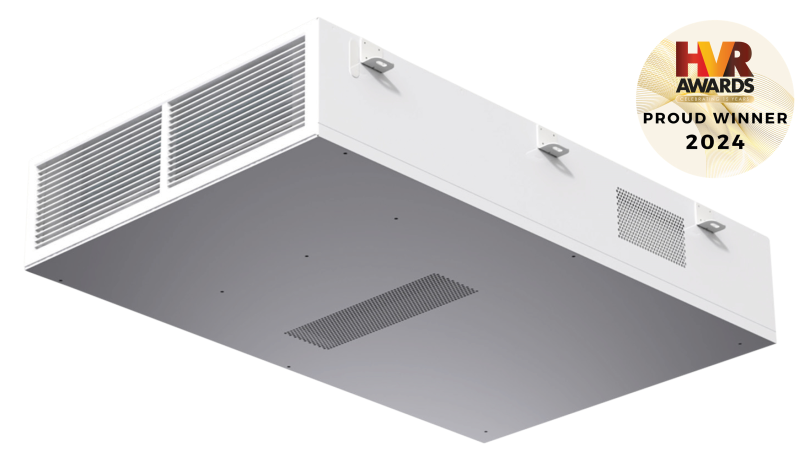Breathing Building's CPD is now CIBSE approved
The course is designed to give attendees a better understanding of the different ventilation strategies that can be used in education and commercial buildings, with a focus on natural, hybrid and hybrid heat recovery technology, and why these systems are needed under current building regulations.
Continuing Professional Development is a long-term commitment to undertake, maintain, improve, and broaden knowledge and skills. CIBSE members are required by the Code of Professional Conduct to maintain professional competence with CIBSE providing clear guidance and support for professional development to enable members to develop their career. Breathing Buildings’ aim is to help construction professionals widen their knowledge regarding the different ventilation strategies available to ensure buildings have energy efficient ventilation that improves indoor air quality (IAQ) and thermal comfort.
The Breathing Buildings ‘Ventilation for Education and Commercial Buildings’ CPD therefore provides delegates with a greater understanding of:
The basics of natural ventilation
Mixing ventilation
New hybrid heat recovery and mixing systems
Current requirements and legislation affecting buildings
Ventilation strategies
Examples of natural ventilation applications.
the one-hour CPD delegates will have the opportunity to find out more about the next generation of sustainable hybrid ventilation with heat recovery, such as the company’s NVHRe - Natural Ventilation with Heat Recycling and Heat Recovery. This is timely since the CPD comes as CIBSE introduced a mandatory requirement from 2024 for members to undertake CPD courses around sustainability and safety.
“We are thrilled that this CPD course is now CIBSE-approved. ‘Ventilation for Education and Commercial Buildings’ aims to help specifiers select the right solution for their building” said Louise McHugh, Product Manager at Breathing Buildings. “The UK has a legal target to meet Net Zero by 2050 so it’s vital that specifiers consider how to reduce carbon in our buildings. Choosing a low carbon ventilation strategy can help, such as natural, hybrid or hybrid with heat recovery ventilation. This CPD outlines these systems as well as how they can help meet regulations and provide good indoor air quality and thermal comfort.”
Delegates will find out more about how specifiers can reduce the amount of energy used in a building and reduce carbon emissions by using natural ventilation within a ventilation strategy, whether natural, hybrid or hybrid with heat recovery ventilation. Natural ventilation is a low energy way to provide a flow of fresh air through a building using the natural forces of wind and/or buoyancy. With modern buildings tending to be well insulated, to prevent rising CO2levels you need to provide fresh air. Natural ventilation is a low energy way to provide this fresh air using the natural tendency of hot air to rise and cold air to sink.
Meanwhile, the CPD will explain how hybrid ventilation combines both natural and mechanical ventilation solutions using mechanical fans only when natural ventilation is not sufficient. This minimises the energy consumption of the ventilation system whilst ensuring sufficient ventilation capacity under a wide range of conditions. Hybrid ventilation is an ideal solution for commercial buildings with high heat gains such as schools, colleges, leisure centres, offices, theatres and even churches. Hybrid ventilation is highly efficient and makes use of the free heat (and so energy) that has already been built up within a space. By installing hybrid ventilation, commercial buildings can maximise health, comfort and sustainability without having to invest in significant building works, making it ideal for retrofitting.
The CPD will also outline the latest hybrid technology. Hybrid ventilation is now available with the addition of a low resistance heat exchanger cell, providing both heat recycling and heat recovery thereby reclaiming even more heat, saving more energy, providing greater occupant comfort, and allowing users to include it within the building energy assessments (SBEM). Breathing Building’s Natural Ventilation with Heat Recycling and Heat Recovery (NVHRe) hybrid ventilation unit boasts the lowest energy consumption for a hybrid heat recovery ventilation unit in the industry. It combines 46% heat recovery efficiency with low Specific Fan Power (SFP) of 0.075 W/l/s to help maximise a building’s energy savings. In addition, the NVHRe has several different operating modes to minimise energy use, enhance IAQ and improve occupant comfort. An intelligent hybrid system, the unit automatically decides when and if mechanical operation is required, ensuring it only operates when absolutely necessary.
Providing excellent thermal comfort and enhanced IAQ, the inclusion of a low resistant aluminium cross plate heat exchanger to the unit lowers energy costs by reducing the reliance on space heating to maintain thermal comfort in a room. It operates during colder external temperatures, typically below 7ºC when mixing recycled air alone is not enough to maintain the desired temperature for occupants.
The range also includes units that can be the primary source of heat; needing no radiators, as well as a system that can offer further cooling. The British designed and manufactured units come in three models with product variations to suit every need with the standard NVHRe 1100 an NVHRe+ 1100 which includes a heating coil and is ideal for buildings in cooler areas; and an NVHRe C+ 1100 which features both heating and cooling coils for year-round comfort and full temperature control.
To book Breathing Buildings’ CIBSE-approved CPD with one of its experienced ventilation experts, email info@breathingbuildings.com or call +44 (0) 1223 450 060. Find out more at https://www.breathingbuildings.com/knowledge/seminars-cpds/.
For further information on NVHRe and other products and services offered by Breathing Buildings, visit www.breathingbuildings.com
